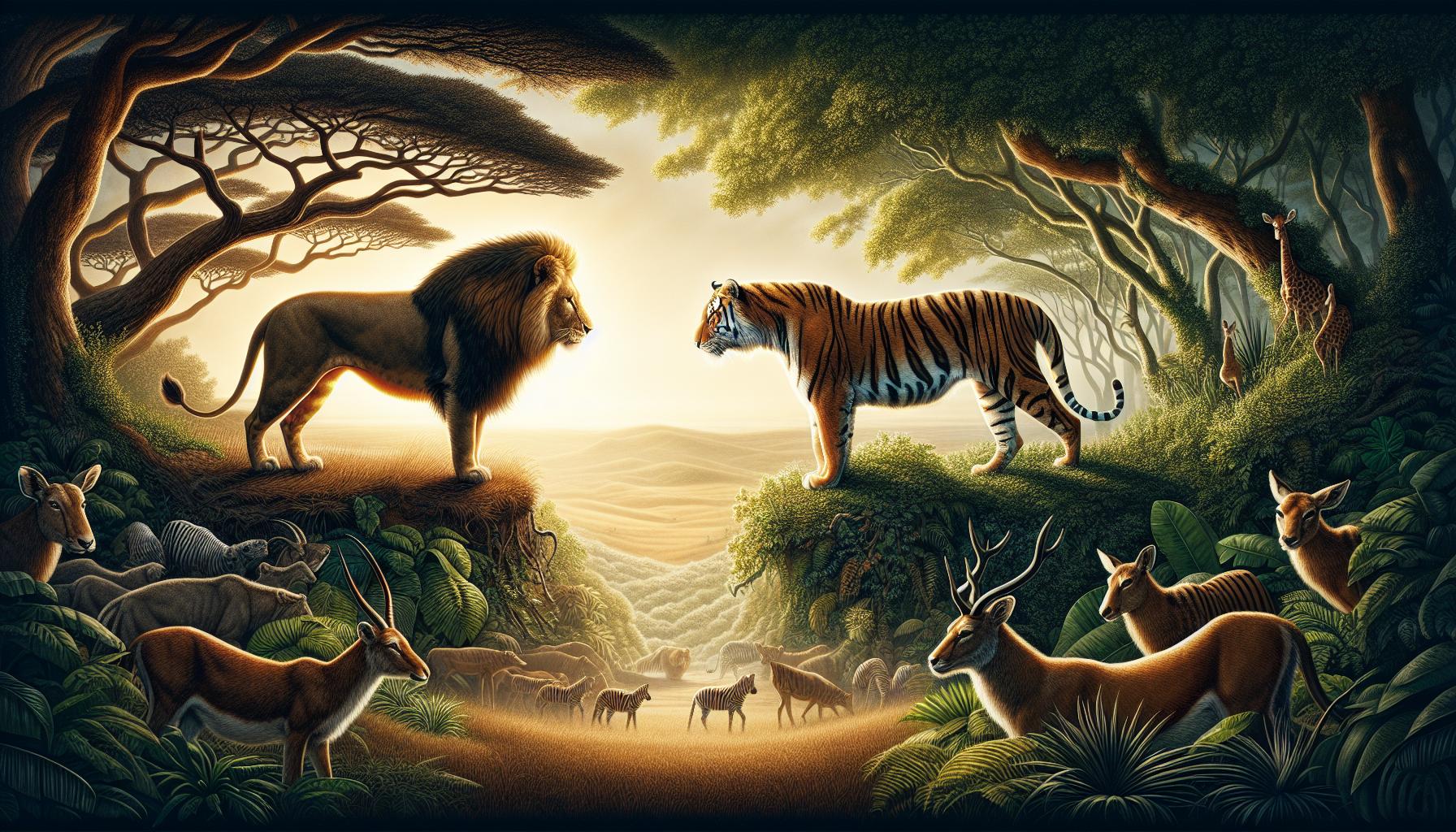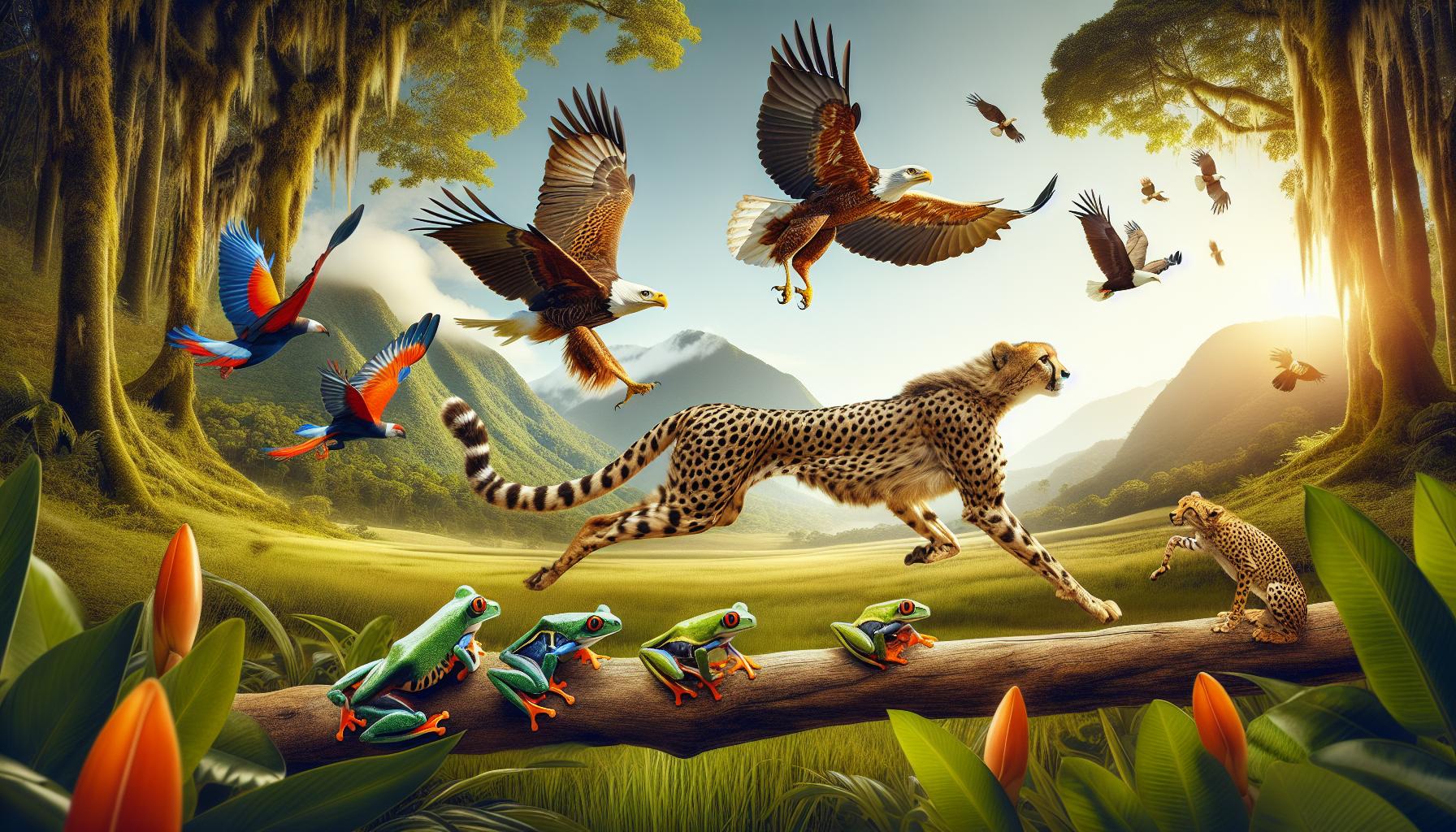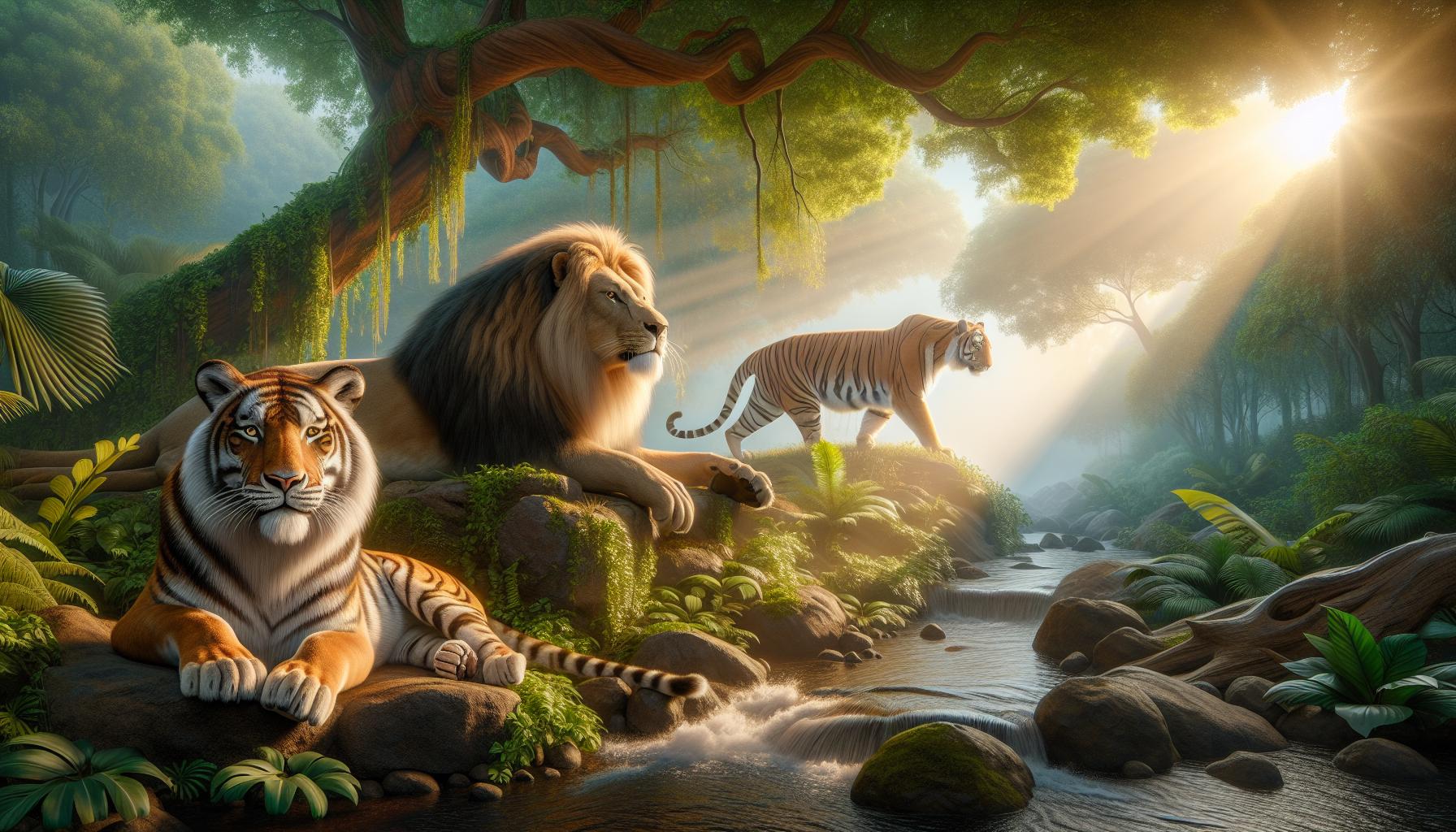In the animal kingdom, the rivalry between lions and tigers captivates the imagination of many. These two apex predators not only symbolize power and majesty but have also been the subjects of legendary battles throughout history. Exploring the dynamics of a lion versus a tiger fight reveals more than just who would win; it immerses us in their behaviors, strengths, and survival instincts, enriching our understanding of wildlife.
With ancient records hinting at spectacular showdowns in Roman arenas, the outcomes often favored tigers, renowned for their superior size, strength, and fighting techniques. Yet, the question remains: what truly influences the outcome of these encounters? By delving into the facts and fables that surround these majestic beasts, we can uncover valuable insights about their respective roles in ecosystems and the importance of conserving these incredible species.
Join us as we analyze these legendary battles and the real-life implications of a lion versus tiger confrontation, fostering a deeper appreciation for these remarkable animals and their natural history.
Contents
- 1 The Natural Rivalry: Lion vs. Tiger Explained
- 2 Behavioral Insights: Hunting Techniques of Both Species
- 3 The Physical Advantages: Strength, Speed, and Agility
- 4 Myth vs. Reality: Actual Encounters between Lions and Tigers
- 5 Cultural Impact: Lions and Tigers in Mythology and Folklore
- 6 The Role of Habitat: Where Lions and Tigers Thrive
- 7 Preservation Challenges: Conservation Status of Big Cats
- 8 Lessons from Nature: What We Can Learn from These Apex Predators
- 9 Tiger vs. Lion in Pop Culture: Movies, Literature, and Art
- 10 Wildlife Conservation Efforts: Protecting Big Cats Worldwide
- 11 Comparative Social Structures: Pride vs. Ambush Dynamics
- 12 Practical Guide: Caring for Your Exotic Pets Responsibly
- 13 Frequently Asked Questions
- 14 In Retrospect
The Natural Rivalry: Lion vs. Tiger Explained
The rivalry between lions and tigers is not just a product of myth or popular culture; it is rooted in the distinct ecological and behavioral traits of these powerful big cats. As apex predators, they each dominate their respective habitats-lions in the savannahs and tigers in the dense forests-and their adaptations reflect the challenges they face within those environments. Lions are known for their social structures, living in prides that work together to hunt and protect their territory, while tigers are solitary hunters, using stealth and strength to take down larger prey. This fundamental difference in social behavior plays a crucial role in their interactions.
Although the imagination is rife with images of lion vs. tiger battles, such encounters are virtually non-existent in the wild due to their different habitats and lifestyles. When they do meet, typically in captivity, the outcomes can be unpredictable. While some claim that tigers often dominate in these contests, reports and historical accounts vary widely, and the reality emphasizes that both species possess unique strengths. Tigers, for instance, are generally larger and possess greater muscle mass, giving them an advantage in sheer power, whereas lions benefit from their pack dynamics and cooperative strategies which can be advantageous in group scenarios.
Ultimately, understanding the rivalry between these iconic species requires recognizing their remarkable adaptations to their specific environments. By celebrating their differences rather than focusing solely on their competitive aspects, we can gain deeper insights into their behaviors and the conservation needs that must be met to protect these majestic animals from threats like habitat loss and poaching. This understanding also promotes responsible pet ownership, reminding us that while many admire these great cats from afar, they require dedicated effort and resources to ensure their survival in the wild.
Behavioral Insights: Hunting Techniques of Both Species
As apex predators, lions and tigers have honed their hunting techniques to thrive in their respective environments. While they share the same family, their methods reflect the distinct settings in which they hunt, leading to varied strategies, strengths, and outcomes during encounters.
Lions, social hunters that roam the open savannahs of Africa, depend heavily on their pride dynamics to capture prey. Their cooperative hunting techniques often involve strategic roles among pride members. The females primarily do the hunting, working together to encircle and ambush herds of wildebeest, zebras, and other ungulates. Using their superior numbers, they can wear down larger prey through coordinated movements and tactics. The power of their teamwork not only increases their success rate but also allows them to take down prey much larger than themselves, demonstrating the potency of social structure in hunting.
In contrast, tigers employ solitary hunting strategies, utilizing their extraordinary stealth and strength to ambush prey in the dense forests and jungles of Asia. With their striking stripes providing camouflage among the foliage, tigers are masters of patience, often stalking their target before launching a powerful surprise attack. They generally favor large prey such as deer, buffalo, and sometimes even young elephants, using their muscular build and sharp retractable claws to bring down animals with a swift, calculated pounce. Tigers’ solitary nature allows them to rely on individual skill and deception, often using natural cover to mask their approach, making them formidable hunters in their own right.
Understanding these behavioral insights underscores the disparities in how these two magnificent animals hunt and interact with their environments. For anyone interested in exotic pet ownership, it’s critical to appreciate that both lions and tigers embody unique behavioral traits that are not easily replicated in domestic settings. Responsible pet care requires recognizing the wild instincts of these animals, ensuring they are treated with the respect and attention necessary for their physical and mental well-being. Whether observing their natural behaviors in the wild or considering them in captivity, the intricacies of their hunting techniques remind us of the ongoing need for conservation and respect for their natural habitats.
The Physical Advantages: Strength, Speed, and Agility
Among the big cats, the might of the lion and the ferocity of the tiger have sparked imaginations and debates for centuries. When it comes to a theoretical matchup between these two apex predators, understanding their physical advantages can illuminate the discussion. Both species possess unique attributes that contribute to their survival and hunting prowess, setting the stage for fascinating comparisons in strength, speed, and agility.
Lions, weighing between 330 to 550 pounds, are equipped with a muscular build that allows them to execute powerful physical maneuvers. Their robust front legs serve as formidable weapons, aiding in taking down large prey during cooperative hunts. Male lions, often characterized by their impressive manes, also possess larger body mass than their female counterparts, enhancing their strength during confrontations. Furthermore, lions can reach speeds of up to 50 miles per hour in short bursts, allowing them to close distances quickly when launching an attack on prey.
On the other hand, tigers are slightly larger in frame and weigh between 220 to 660 pounds, depending on the subspecies. They are also built for agility, showcasing an incredible combination of speed and stealth. Tigers can sprint at remarkable speeds of about 30 to 40 miles per hour but have the advantage of a powerful leap that can span over 25 feet, making their ambush techniques highly effective in their dense forest habitats. Their retractable claws and notoriously strong jaws allow them to grapple with and subdue prey much larger than themselves, giving them a crucial edge in one-on-one situations.
Despite their formidable strengths, both species have their unique advantages based on their hunting styles and environments. While a lion’s power and social hunting dynamics aid in capturing prey as a team, the tiger’s solitude and stealth provide it with the ability to hunt effectively at night and navigate through challenging terrains. These distinctions not only showcase the adaptations of each species but also underpin the need for understanding and respecting their natural behaviors.
As we explore the dynamics of lion verses tiger and reflect on their physical attributes, it becomes clear that these magnificent animals embody the essence of predator prowess. For those who admire these creatures in captivity, it is vital to acknowledge their innate instincts and provide an environment that respects their powerful physicality. With proper care, owners can appreciate the strength and agility of these big cats while ensuring their well-being and preserving their richness of character.
Myth vs. Reality: Actual Encounters between Lions and Tigers
While tales of lions battling tigers have captivated audiences for generations, the reality of these encounters is far more complex than mere legend. Actual skirmishes between these apex predators, typically confined to captivity, reveal intriguing insights into their behaviors and instincts. Notably, a significant factor leading to confrontations often stems from a lion’s more aggressive nature. In controlled environments, such as zoos or animal parks, when these two species are placed in proximity or forced into conflict, many times it is the lion that instigates the clash, showcasing its instinctual drive to assert dominance and territory, a behavior less prominent in solitary tigers.
In the wild, such confrontations are virtually nonexistent, as lions and tigers inhabit different territories and ecosystems. Therefore, direct clashes remain a rarity, mostly portrayed through fictional battle scenarios rather than genuine encounters. However, studying their behaviors provides a treasure trove of understanding. For instance, lions are social animals that live in prides, fostering a cooperative hunting strategy that could give them an edge when working together against a solitary tiger. In contrast, the tiger’s individual tactics emphasize stealth and strength, allowing it to tackle larger prey alone, which is crucial for its survival in dense forest environments.
Moreover, real-life examples of captivity conflicts, as noted in various wildlife studies, suggest that in many instances, a lion could overpower a tiger due to its size and social nature. Lions typically weigh more, with male lions forming a robust physique designed for overpowering large prey. On various occasions, recorded encounters have shown that lions can sustain prolonged physical confrontations through sheer tenacity. Yet, this does not definitively encapsulate the capabilities of a tiger, which possesses remarkable agility and striking precision, making it a formidable opponent when it chooses to engage.
Understanding these dynamics is essential, especially for those professionals and enthusiasts involved in wildlife conservation and big cat care. Promoting environments that mitigate aggressive instincts is crucial in captivity, where both lions and tigers may exhibit stress or harmful behavior when confined. Proper socialization and habitat enrichment can alleviate conflicts and ensure that these majestic animals thrive within their surroundings. What’s clear is that while the legendary battles between lions and tigers ignite fascination, the truth lies in respecting their unique attributes and maintaining their natural instincts as gracefully as possible.
Cultural Impact: Lions and Tigers in Mythology and Folklore
Throughout various cultures, lions and tigers have emerged as powerful symbols in mythology and folklore, often depicted in legendary battles that reflect not only the creatures’ physical prowess but also their roles as cultural icons. For instance, in many traditions, the lion is seen as the embodiment of courage, nobility, and strength, revered in societies from ancient Egypt to medieval Europe. The striking depiction of lions as kings of the animal kingdom has made them central figures in royal emblems, artistry, and literature. Conversely, the tiger, associated with agility, ferocity, and solitary strength, has become a prominent figure in Asian cultures, celebrated for its beauty and revered as a protector and a fierce warrior.
In folklore, the rivalry between these two apex predators often symbolizes a struggle between contrasting virtues. In Hindu mythology, for example, the goddess Durga rides a lion or a tiger, embodying the fusion of power and grace, showing that both animals represent different aspects of divinity and strength. Such stories highlight cultural values around bravery and individualism, where the tiger’s stealth and the lion’s raw power are traits that each culture admires in their own context. This interplay of attributes has allowed these big cats to penetrate fiction and storytelling, becoming metaphors for human traits or societal challenges.
Moreover, ancient civilizations often used these mighty animals as devices to explain natural phenomena or moral lessons. The lion’s roars are likened to thunder, representing strength and authority, while the tiger’s stealthy hunts reflect cunning and survival instincts. These narratives foster a deeper appreciation for the natural world, reminding us not just of the environmental roles these animals play but also of their integral place in human culture.
As these legendary battles between lions and tigers take hold of the imagination, they also raise questions about the responsibility of modern society to protect these magnificent creatures. The traditions that celebrate them must find a way to coexist with contemporary conservation efforts, ensuring that the legacy of these great beasts is not lost to extinction. Understanding their significance in folklore can lead to a greater respect for their real-life struggles; thus, fostering a desire to protect their habitats and advocate for their survival in the wild.
The Role of Habitat: Where Lions and Tigers Thrive
In the wild, the habitats of lions and tigers are distinctly shaped by their adaptations and behavioral needs, significantly influencing how these magnificent creatures thrive and interact within their environments. Lions predominantly inhabit the savannas, grasslands, and open woodlands of Africa, with a small population residing in the Gir Forest of India. Their social structure, characterized by prides, allows them to leverage the vast expanses of their habitat for cooperative hunting and territorial defense. In this environment, visibility is key; the open landscape enables lions to use their strength and social dynamics to bring down prey and establish dominance.
In contrast, tigers are primarily found in the dense forests, mangroves, and grasslands of Asia, with a significant presence in India. Their solitary nature and hunting style are highly adapted to the cover provided by thick vegetation, which allows them to rely on stealth and ambush tactics. Tigers are also adept swimmers and can often be found near water sources, using rivers and lakes to their advantage in hunting and territory maintenance. This difference in habitat requirements highlights a fundamental divergence in behavior; while lions depend on social cooperation, tigers utilize solitary stealth as their primary strategy.
Understanding the role of habitat underscores the rarity of interactions between these big cats in the wild. Historical ranges for both species did overlap in parts of Asia, but geographical constraints have led to their distinct separations today. This habitat division corroborates why real-life encounters between lions and tigers are virtually nonexistent, eliminating the legendary battles often depicted in folklore and popular culture.
To appreciate these majestic animals further, one must consider the unique environmental roles they play. As apex predators, both lions and tigers are critical in maintaining ecological balance within their respective habitats, controlling herbivore populations and ensuring the health of their ecosystems. For wildlife enthusiasts and pet owners alike, understanding these dynamics can enrich the experience of observing these creatures in captivity or their natural settings, reinforcing the importance of responsible conservation efforts to protect their habitats from encroachment and degradation.
Preservation Challenges: Conservation Status of Big Cats
The majestic stature of both lions and tigers evokes awe and fascination, yet the harsh reality is that these apex predators are increasingly threatened by human activities. While mythical tales of battles between lions and tigers captivate our imaginations, the real fight for survival is played out in conservation statuses that are, sadly, alarming. Both species face unique challenges that dictate their futures in the wild, spurred by a combination of poaching, habitat destruction, and the encroachment of human populations.
Lions, primarily native to the savannas of Africa, have seen their numbers plummet by approximately 40% over the past two decades. Currently, it is estimated that only about 20,000 lions remain in the wild, confined to pockets of protected areas where they can find safety and sufficient prey. Poaching for bushmeat and traditional medicine, alongside retaliatory killings due to livestock attacks, adds to the pressures faced by lion populations. Conservation efforts are underway, but they require significant funding and community involvement to establish sustainable practices that ensure coexistence between lions and local populations.
Tigers, on the other hand, are equally beleaguered, with their populations estimated at around 5,574 individuals remaining in the wild. Their struggle is compounded by habitat loss due to logging, agriculture, and urban expansion, which have reduced their territory by approximately 93%. These big cats are particularly vulnerable to the illegal wildlife trade, driven by the demand for tiger bones and body parts in traditional medicine, as well as the exotic pet trade. International efforts to curb poaching and habitat loss have shown promise, with some tiger subpopulations starting to stabilize. However, the overall future of tigers hangs in the balance, necessitating immediate global action.
Engaging in responsible pet ownership can also have an indirect impact on conservation efforts. Educating oneself about the realities of big cat ownership and recognizing the complexities involved in caring for these animals can discourage potential buyers from seeking exotic pets, thus reducing the demand and pressure on wild populations. Moreover, supporting conservation organizations, participating in wildlife education, and advocating for policies that protect natural habitats can make a tangible difference for both lions and tigers in their wild domains.
As we delve deeper into the lives of these incredible creatures, it becomes clear that their survival is not merely a fight against extinction but a plea for understanding, respect, and responsible stewardship of our shared planet. By championing conservation initiatives and promoting awareness, we can help shape a future where lions and tigers thrive, rather than merely surviving in isolated ecosystems.
Lessons from Nature: What We Can Learn from These Apex Predators
Both lions and tigers, as apex predators, provide profound insights into the complex dynamics of the animal kingdom and the delicate balance of ecosystems. Observing their behaviors and interactions can teach us invaluable lessons about adaptability, social structures, and the importance of conservation efforts.
The fierce independence of tigers, preferring to hunt alone in dense forests, contrasts sharply with the cooperative nature of lions, who thrive in social groups called prides. This division underscores the significance of social structures within species and how they adapt to their environments. Lions display strong cooperation in hunting and raising cubs, showcasing the power of teamwork and shared responsibilities. In contrast, the solitary nature of tigers emphasizes the necessity for stealth and strategic hunting techniques, adapting to their solitary lifestyle by relying on keen senses and strength for survival. This highlights the idea that different strategies can effectively lead to successful survival, a concept deeply relevant in both wildlife and human communities.
From a conservation perspective, the plight of these majestic cats imparts critical lessons about environmental stewardship. The stark contrast between their populations-tigers facing severe threats from habitat loss and poaching, while lions contend with diminishing territories and human-wildlife conflict-underscores the urgency for coordinated conservation efforts. Engaging in responsible pet ownership can play a part in this narrative; potential pet owners need education about the complexities of caring for big cats, which can help reduce demand for exotic pets. Understanding that each species has a unique role in its ecosystem encourages individuals to support conservation initiatives that protect their habitats and sustain biodiversity.
Moreover, the legendary battles between lions and tigers, while largely mythical, remind us of the rich narratives woven into the fabric of our ecosystems. They serve as a clarion call for a deeper appreciation of these animals, urging society to appreciate their roles beyond mere fascination. By learning from these apex predators, we can advocate for sustainable practices that not only preserve their populations but also enrich our understanding of the natural world, ultimately fostering a more harmonious coexistence with wildlife.
Tiger vs. Lion in Pop Culture: Movies, Literature, and Art
The battle between lions and tigers has captured the imagination of countless storytellers, filmmakers, and artists throughout history, leading to a vibrant tapestry of portrayals in pop culture. These majestic big cats symbolize strength, valor, and the primal struggles of survival, often depicted in a grand narrative of conflict and rivalry. Their contrasting traits-lions as social hunters and tigers as solitary prowlers-add layers of complexity to their representations in various forms of media.
In cinema, films such as “The Jungle Book” and “Life of Pi” showcase tigers often with an air of mystery and independence, while lions are portrayed in family-oriented roles, as seen in classics like “The Lion King.” The famous climactic roar-off between these species taps into our age-old fascination with their power, but it’s crucial to remember that these portrayals are artistic embellishments rather than reflections of real animal behavior. Encounters between lions and tigers in the wild are incredibly rare, primarily due to geographical separation, as lions inhabit the African savannah, while tigers roam the forests of Asia.
Literature has echoed similar themes, with works ranging from fables to classic novels exploring the symbolism of these animals. They are often employed as metaphors for human emotions-courage and pride with lions, cunning and stealth with tigers. In Aesop’s fables, the lion embodies nobility but is not free from deceit, while portrayals of tigers can signify unrestrained ferocity and independence.
As these beautiful creatures become more entangled in our fictional worlds, it becomes increasingly important for audiences to distinguish between myth and reality. Understanding their true nature assists in fostering proper respect and conservation efforts. For those interested in exotic pets, the majestic traits of lions and tigers can lead to misguided aspirations; responsible pet ownership begins with appreciating the complexities of these animals and their needs, far beyond the glamorous images we often see in our favorite books and films. Approaching the fascination with these apex predators should drive a dedication to wildlife preservation, ensuring that future generations can appreciate the lion’s roar and the tiger’s stealth, not just on screen, but in their natural habitats.
Wildlife Conservation Efforts: Protecting Big Cats Worldwide
The future of lions and tigers hangs in the balance, reminding us that the legendary battles portrayed in our imaginations must be supported by real-world conservation efforts. With their populations dwindling due to habitat loss, poaching, and human-wildlife conflict, it has never been more critical to ensure the survival of these majestic big cats. Organizations and dedicated individuals around the globe are uniting to create robust strategies that protect not just these iconic predators, but the ecosystems they help sustain.
One effective approach has been the collaboration between governments, non-profits, and local communities to protect habitats essential for the survival of both lions in Africa and tigers in Asia. Efforts like the Global Tiger Initiative aim to double the number of wild tigers through the restoration of habitats and strict anti-poaching measures. In this context, it’s not only about the cats but also about fostering a balance where human activities and wildlife coexist harmoniously. Education is vital; programs that empower local communities to understand the ecological significance of these apex predators often lead to stronger commitments to conservation.
Conservation status varies widely between species. For instance, the IUCN Red List categorizes lions as vulnerable, with less than 23,000 left in the wild, primarily due to habitat encroachment and conflict with human populations. Conversely, tigers are listed as endangered, with around 3,900 individuals remaining. Both scenarios highlight the importance of immediate action. Sustainable tourism initiatives that generate revenue for conservation efforts can also benefit local economies while encouraging wildlife protection.
As stewards of the environment, it is our responsibility to foster these conservation endeavors. Contributing to organizations dedicated to wildlife protection, participating in community awareness programs, or even adopting sustainable practices can make a tangible difference. Take for example the adopt-a-tiger program by WWF, where funds support anti-poaching patrols and habitat preservation, ensuring that these incredible creatures remain a part of our world. Protecting big cats is a shared mission; every effort counts in the ongoing battle for their survival.
Comparative Social Structures: Pride vs. Ambush Dynamics
Lions and tigers, two of the most iconic big cats, embody vastly different social structures that significantly influence their behaviors, hunting techniques, and interactions within their respective environments. Lions are social animals, living in groups known as prides, which typically consist of a few males, numerous females, and their young. This social dynamic allows lions to cooperate during hunting, often targeting larger prey like wildebeests or zebras. The pride structure enhances their capability to control territory and ensure the safety of cubs from external threats, particularly from rival males seeking to take over the pride.
In contrast, tigers are solitary and territorial animals, with males often establishing territories that can be several times larger than their female counterparts. This solitary lifestyle has adapted them to rely on stealth and ambush tactics while hunting. Tigers are experts in utilizing their environment, employing elements of surprise to take down prey such as deer and wild boar. When moving through their territory, these big cats exhibit behaviors that reflect their need for a large personal space, limiting social interactions primarily to mating periods.
The differences between the pride dynamics of lions and the ambush strategies of tigers extend to their reproductive strategies as well. In a lion pride, the stability of the group often allows for cooperative care of young, enhancing the survival rates of cubs. However, in tiger populations, a male may kill the cubs of another male upon taking over territory to mate with the females, a practice that reflects the harsh realities of their solitary existence. This rivalry shapes not only their social structures but also their survival strategies, with lions relying on cooperation and tigers on competition.
Understanding these contrasting dynamics not only deepens our appreciation for these magnificent creatures but also highlights important considerations for their conservation. By fostering environments where both pride- and ambush-oriented species can thrive, we can better support their unique lifestyles and the delicate ecosystems they inhabit. Those interested in supporting wildlife can engage in efforts that promote habitat preservation and respect the natural behaviors of these apex predators, contributing to a future where both lions and tigers can continue to dominate their realms.
Practical Guide: Caring for Your Exotic Pets Responsibly
The allure of owning exotic pets like lions and tigers can be captivating, but it is essential to approach such responsibilities with grounded understanding and respect for these magnificent creatures. While many people dream of domesticating a big cat, the reality is that they are intricate beings with specific needs that are often challenging to meet in a home environment. For example, lions require extensive territory, social interaction, and specialized dietary needs, while tigers thrive on solitary and enriched environments that mimic their natural habitats.
Understanding the Responsibilities
Before considering owning an exotic pet, one must assess the commitment involved. Big cats are not merely pets; they are wild animals with instincts and behaviors shaped by eons of evolution. Maintaining a healthy, humane environment for these creatures requires extensive knowledge about their dietary, environmental, and social needs. Potential owners should also consider the legal implications, as many regions enforce strict laws regarding the ownership of big cats, often prohibiting private ownership altogether due to safety and conservation concerns.
Providing Proper Care
If you’re already caring for or planning to care for an exotic cat, here are crucial factors to consider to ensure their well-being:
- Space: Exotic cats require vast areas to roam-often equivalent to the size of a small zoo exhibit. A typical home cannot accommodate a lion’s or tiger’s territorial needs.
- Diet: These animals require a raw meat diet rich in nutrients that replicate what they would naturally consume in the wild. This often means sourcing large quantities of high-quality meat, an expensive and labor-intensive endeavor.
- Veterinary Care: Finding a veterinarian with expertise in exotic animals is essential. Routine and emergency health care for big cats can be complicated, needing specialized knowledge and resources.
- Socialization: While lions benefit from the company of pride members, tigers are solitary. Mimicking their natural environments and interactions is critical to their psychological well-being.
Conservation Implications
Owning a big cat also poses broader implications for conservation efforts. The illegal wildlife trade thrives on the demand for exotic pets, which undermines global conservation initiatives aimed at preserving wild populations of these animals. Instead of supporting the exotic pet industry, consider contributing to reputable wildlife sanctuaries or conservation organizations focused on protecting these majestic species in their natural habitats. Engaging with conservation programs fosters a greater understanding of wildlife preservation and encourages responsible, educated stewardship of our planet’s natural heritage.
In sum, the fascination with lions and tigers should guide us toward protecting them in the wild rather than bringing them into our homes. Embracing the role of a responsible advocate for wildlife will not only enrich our understanding of these incredible animals but contribute to their survival for future generations.
Frequently Asked Questions
Q: Who would win in a fight: a lion or a tiger?
A: While both lions and tigers are formidable predators, tigers generally have the advantage in one-on-one encounters due to their larger size and solitary hunting style. However, such fights are rare and often influenced by individual circumstances. For more insights, refer to the section on “Myth vs. Reality: Actual Encounters between Lions and Tigers.”
Q: What are the main differences in hunting tactics between lions and tigers?
A: Lions often hunt in groups, utilizing teamwork to take down prey, while tigers are solitary hunters, relying on stealth and strength. Understanding these techniques can provide key insights into their respective survival strategies found in “Behavioral Insights: Hunting Techniques of Both Species.”
Q: How do lions and tigers compare in terms of strength and agility?
A: Tigers are generally stronger and more agile than lions, which contributes to their hunting success in various terrains. Lions, though powerful, have slightly less agility due to their size and social structure. Explore more in “The Physical Advantages: Strength, Speed, and Agility.”
Q: Have lions and tigers ever coexisted in the wild?
A: No documented cases exist of lions and tigers coexisting in the wild, primarily due to their differing habitats and social structures. Lions are native to Africa, while tigers primarily inhabit Asia. This topic is discussed further in “The Role of Habitat: Where Lions and Tigers Thrive.”
Q: What role do lions and tigers play in their ecosystems?
A: Both lions and tigers serve as apex predators, helping to maintain healthy ecosystems by controlling herbivore populations. This balance prevents overgrazing and allows for biodiversity to flourish. For more ecological insights, view “Lessons from Nature: What We Can Learn from These Apex Predators.”
Q: Are lions and tigers facing similar conservation challenges?
A: Yes, both species face significant threats, including habitat loss, poaching, and human-wildlife conflict. However, their conservation statuses differ, with tigers being critically endangered and lions vulnerable. For specific challenges, check “Preservation Challenges: Conservation Status of Big Cats.”
Q: Why are lions and tigers popular in culture and media?
A: Their majestic appearance and powerful nature make lions and tigers symbols of strength and bravery in various cultures. They have been depicted in literature, films, and art, reflecting humanity’s fascination with these apex predators. Learn more in “Tiger vs. Lion in Pop Culture: Movies, Literature, and Art.”
Q: What can we learn from the social structures of lions and tigers?
A: Understanding the pride dynamics of lions versus the ambush tactics of tigers can offer insights into their adaptability and survival strategies. This comparison enriches our knowledge of animal behavior and ecology. Delve into “Comparative Social Structures: Pride vs. Ambush Dynamics” for more details.
In Retrospect
As we conclude our exploration of the legendary battles between lions and tigers, it’s clear that understanding these magnificent creatures offers insights into their behaviors and life in the wild. Whether you were fascinated by the ferocity of these animals or intrigued by the outcomes of their encounters, there’s so much more to learn! If you’re eager to dive deeper into wildlife science or looking for pet care tips inspired by these big cats, check out our articles on “Majestic Creatures: The Role of Predators in Ecosystems” and “How to Care for Your Feline Friend: Lessons from the Wild.”
Don’t miss the chance to stay informed! Subscribe to our newsletter for the latest updates and insights into animal behavior, ensuring you never miss an exciting post. Your thoughts matter, so feel free to leave a comment below – what are your impressions of these legendary battles? Engage with our community and let’s keep the conversation going!
To further your understanding, consider exploring our resource on wildlife conservation efforts, which can provide a broader context to the lives of lions and tigers. Remember, every visit enriches your learning journey while supporting our mission to share knowledge about wildlife and responsible pet ownership.





